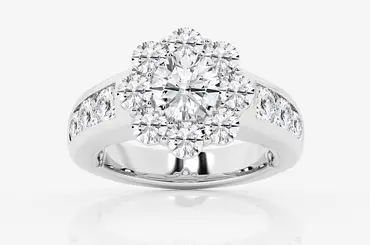The hairstylist community took the term ‘ombre’ from the French word shaded or shading. Ombre hair color is mainly and normally darker at the roots through the mid-shaft and then slowly gets lighter from the mid-shaft to the ends.
One can have ombre hair color using a balayage technique, and it is also adopted by clients looking for a low-maintenance style.
Ombre hair features a gradient effect where the hair transitions from a darker shade at the roots to a lighter shade at the ends. This stylish and low-maintenance look can be achieved at home with preparation and patience. In this blog post, we will describe the basic steps to ombre your hair, ensuring a beautiful and professional-looking result.
How To Ombre Your Own Hair

Step 1: Get your hair and workspace set
Before you begin, set up your workspace. Choose a well-ventilated area and cover any surfaces to protect them from dye stains. Wear old clothes or a salon cape. Brush your hair to remove tangles and divide it into sections, securing each with clips. This makes the application process more manageable. Prepare your hair dye kit, including the dye, a developer, a mixing bowl, a brush, and gloves.
Step 2: Mix the dye
Follow the instructions provided with your hair dye kit to mix the dye. Usually, this involves combining the dye with a developer in the provided mixing bowl. Ensure you mix it thoroughly to get an even color.
Step 3: Apply the dye
Starting with the lowest layers, unclip a section of hair and apply the dye with the brush. Start a few inches away from the roots for a natural ombre effect. Blend the dye downwards towards the ends of your hair, gradually lightening the application as you move down. This gradient effect is key to achieving the ombre look.
Step 4: Let the dye set
Once you’ve applied the dye to all sections, set it for the time recommended in the instructions. This usually ranges from 30 to 45 minutes, depending on the desired intensity.
Step 5: Rinse and add condition
After the waiting period, rinse the dye with lukewarm water until the water runs clear. Then, shampoo and deeply condition your hair to nourish and protect it after dyeing.
Step 6: Dry and style
Gently towel-dry your hair and then use a blow dryer or let it air dry. Once dry, you can style your hair as desired to show off your new ombre look!
Benefits of Ombre Hair

These ombre hair color styles are so trendy because they look great and perfect for everyone, but there are other benefits as well which are:
- Ombre hair adds depth and dimension to your hair, giving it a more youthful and vibrant look.
- Ombre hair can be customized to suit a variety of hair lengths, textures, and skin tones, making it a versatile choice for many people.
- Unlike traditional hair coloring techniques, Ombre hair requires less maintenance, as the color fade is gradual and natural-looking.
- Doing an Ombre hair treatment at home is much less expensive than going to a salon.
- Ombre hair allows you to express your individuality and creativity by choosing colors and styles that suit your personality.
- Ombre hair can be a great solution for those who want to hide they’re growing roots, as the darker roots blend in seamlessly with the lighter tips.
- Ombre hair can make fine or limp hair look fuller, as the lighter tips give the illusion of volume.
Cons of Ombre Hair
1. It may damage hair
Lightening hair for an Ombre treatment can be damaging, especially if the hair is already dry, brittle, or has been chemically treated.
2. It is costly to maintain
Ombre hair requires regular touch-ups to maintain the desired look and prevent the color from looking uneven or patchy.
3. It is difficult to remove
If you decide to change your hair color, removing Ombre hair can be difficult and may require multiple treatments.
4. It can look unnatural
If not done properly, Ombre hair can look unnatural and may result in an unflattering contrast between the two colors.
5. It may not suit all skin tones
Certain Ombre hair colors may not suit all skin tones, so choosing a color that complements your skin tone is important.
6. It requires special care
Ombre hair requires special care, such as using sulfate-free shampoos, regular conditioning treatments, and avoiding heat styling tools
Can I Ombre My Hair at Home?
Yes, you can embrace your hair at home, but it requires careful preparation, attention to detail, and a willingness to take your time.
Choose a hair dye and developer designed for Ombre and follow the instructions carefully.
In addition, before starting, do a patch test to ensure you’re not allergic to the dye, and prepare all the necessary materials, such as gloves, a mixing bowl, and a brush or comb.
If you’re new to hair coloring or unsure about the process, seek the assistance of a professional or consider going to a salon.
Tips to Maintain and Care for Ombre Hair
- Sulfates can strip color from hair, so use a sulfate-free shampoo specifically designed for color-treated hair.
- Excessive heat can damage hair and cause the color to fade, so avoid heat styling tools as much as possible or use them with a heat protectant spray.
- Regular conditioning treatments can help moisturize hair, prevent breakage, and maintain color.
- Exposure to sun and chlorine can cause hair color to fade, so protect your hair by wearing a hat or using a leave-in treatment with UV protection.
- Ombre hair requires regular touch-ups to maintain the desired look, especially for roots that may start to grow.
- Regular trims can help prevent split ends and keep hair looking healthy.
- Be gentle when brushing and combing hair, especially when wet, to avoid damaging the hair shaft and causing breakage.
Is Ombre and Balayage the same thing?
No, Ombre and Balayage are not the same thing. Ombre hair is characterized by gradual lightening from the roots to the ends, creating a gradient effect. Balayage, on the other hand, involves hand-painting highlights onto the hair in a more natural, sun-kissed pattern.
How long does an ombré last?
An Ombre lasts for about 4-6 months, depending on several factors such as the type of dye used, the natural color and condition of the hair, and the amount of styling and exposure to environmental factors.
Conclusion
Ombre is a popular hair coloring technique that gradually lightens the hair from the roots to the ends, creating a gradient effect. This technique can be done at home, although it requires patience, precision, and proper care.
To maintain an Ombre, it’s important to use sulfate-free shampoos, avoid excessive heat styling, touch up roots regularly, and seek professional assistance.







2 Comments
I like how you said to find dyes that are organic and natural because that means they won’t be nearly as bad for your hair. My hair is a brownish color but I think it would be awesome to have it go to blonde at the end! What’s the best way to choose a dye?
Thank you for this comprehensive guide on achieving ombre hair at home! Your step-by-step instructions make the process seem much more manageable, even for someone like me who’s not an expert in hair coloring.
I appreciate the attention to detail in explaining each step, from setting up the workspace to rinsing and conditioning the hair after dyeing. It’s clear that proper preparation and care are essential for achieving a beautiful ombre effect.
The benefits and drawbacks of ombre hair that you outlined are also very helpful. It’s great to know the advantages, such as added depth and dimension, versatility, and lower maintenance requirements. At the same time, understanding the potential challenges, like hair damage and maintenance costs, is crucial for making an informed decision.
The tips for maintaining and caring for ombre hair are invaluable, especially for someone like me who’s considering trying this style for the first time. I’ll definitely keep them in mind to ensure that my ombre hair looks its best for as long as possible.
Overall, this guide has provided me with all the information I need to confidently embark on my ombre hair journey. Thank you for sharing your expertise!